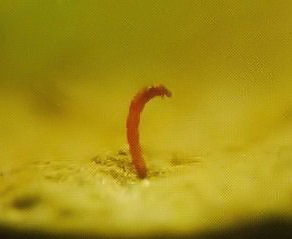SOFIE® is used in many types of studies (check also the Download section):
- The effect of inundation and flooding
ny component that occurs in pore water of soils or sediments can be studied, since pore water is isolated from the system without disturbing the steady state. This includes nutrients, organic contaminants, and heavy metals.
SOFIE® has found uses in many types of studies:
- Inundation / flooding experiments;
- Exposure tests with terrestrial and aquatic organisms;
- Bioturbation and The effect of bioturbation on oxidation and bioavailability, contaminant displacement;
- Fluxes of nutrients to/from sediment and surface water;
- Simulation of long-term sediment storage in pitssand pits and lakes;
- (Geo)chemical oxidation and ripening of drained sediments;
Chironomus (midge) at water-sediment interface.l.
Left: discoloring over short distances in sediment indicate the various redox stages.
Right: Oligocheate population in a SOFIE cell.
- .
Advantages
SOFIE® has at least eight major advantages over existing methods:
- Experiments are carried out in undisturbed samples, including overlying surface water, which are taken with the body core of the cell;
- Characteristic in-situ redox conditions and gradients are maintained;
- Measurements can be carried out in 5 mm layer increments;
- The method is non-destructive to the sample, so pore water can be monitored repeatedly;
- Pore water is micro-filtrated over 0.1 um while sampling;
- Free metal ions can be isolated from solution during pore water sampling;
- Bioassays are carried out simultaneously, thereby accounting for time dynamic exposure concentrations;
- Aerobic or anaerobic conditions can be manipulated by flushing the atmospheric headspace with a gas. In this way, various oxidation or reduction scenarios can be tested.
Aquatic sediments may absorb or release contaminants from/to surface waters and ground water. The rate and amount of which this occurs is generally difficult to determine. Redox processes (oxidation and reduction) dictate the fate of many compounds to a large extent. These cells provide the means to measure redox-discrete processes.
Toxicity of contaminants to aquatic organisms is related to the in-situ chemical speciation. Free ion concentrations can be measured in pore water of the sediment and in the overlying surface water. Toxicity tests can be performed in combination with flow-through cells in which populations of e.g., Daphnids can be contained.
Bioaccumulation studies with Tubifex (left) and Chironimus (right) show that uptake is primarily via the free dissolved phase
See also: www.pnec-pro.com
Redox gradients occur over short distances.
This affect the bioavailability of compounds.









